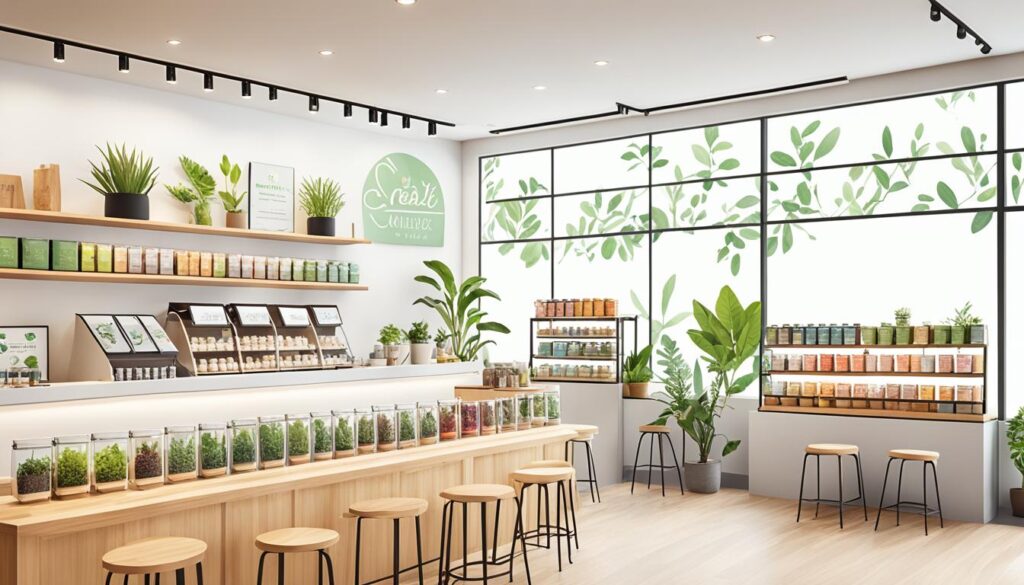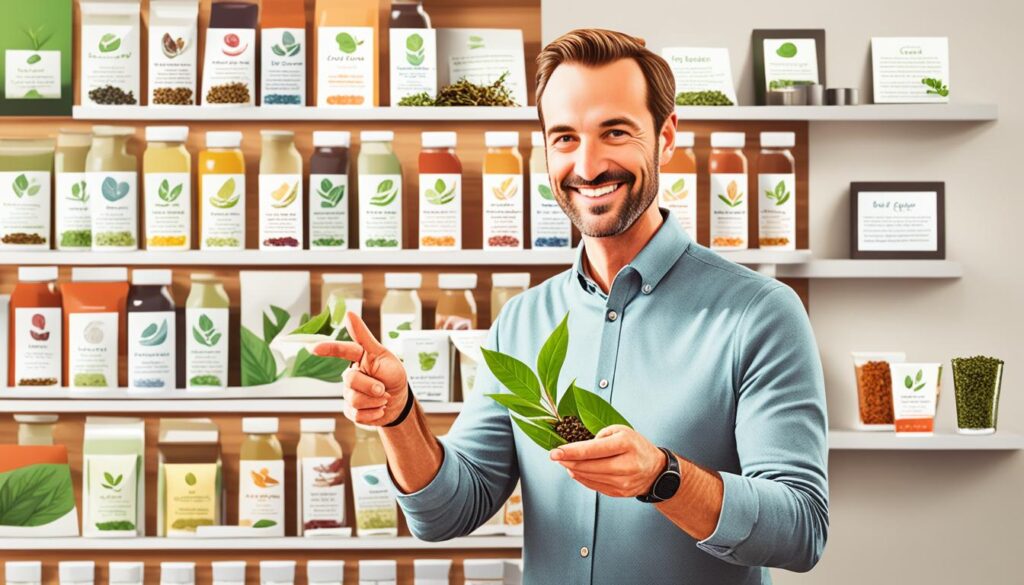Did you know that the loaded tea segment, despite being a small portion of the total tea market, is experiencing rapid growth and offers exceptional prospects? In fact, the bubble tea business is projected to be valued at a staggering $2.75 billion globally in 2022, with the compound annual growth rate of the tea market reaching 8.9% from 2023 to 2030. If you’re a tea enthusiast looking to turn your passion into a profitable venture, starting a loaded tea business might be the perfect blend of entrepreneurship and creativity.
Loaded tea, a trend that’s taking the beverage industry by storm, offers a refreshing twist on traditional tea. These delightful concoctions are bursting with flavors, nutrients, and a touch of indulgence, making them a popular choice among health-conscious millennials and Gen Z consumers who prefer functional drinks. Opening a loaded tea shop allows you to craft unique blends that cater to diverse tastes while promoting a healthier lifestyle.
When it comes to tea entrepreneurship, the initial start-up costs for a loaded tea business range from $35,000 to $90,000, including expenses for product development, packaging, permits, and marketing. Ongoing costs typically range from $7,000 to $20,000 per month, covering expenses such as rent, staffing, equipment maintenance, and marketing. However, with the rising consumer demand for functional teas, the potential for growth and success in this industry is immense.
Key Takeaways
- The loaded tea market is experiencing rapid growth and offers exceptional prospects for entrepreneurs.
- Loaded teas cater to health-conscious consumers who prefer functional drinks.
- Opening a loaded tea shop allows for creative blending and promoting a healthier lifestyle.
- Start-up costs range from $35,000 to $90,000, with ongoing costs of $7,000 to $20,000 per month.
- Legal structure options include sole proprietorship, partnership, LLC, and corporation.
- Registering for an EIN from the IRS is crucial when forming an LLC or corporation.
Understanding the Loaded Tea Industry
In recent years, the beverage industry has witnessed a significant shift towards healthier and more innovative drink options. Among the rising stars in this industry is loaded tea, a unique blend of tea, fruits, herbs, and superfood additives that offers a refreshing and nutritious alternative to traditional tea beverages. As the demand for healthy beverage options continues to grow, the loaded tea business has emerged as a promising venture for entrepreneurs looking to tap into this thriving market.
What is Loaded Tea?
Loaded tea is a type of iced tea that is infused with a variety of ingredients, such as fresh fruits, herbs, spices, and even superfood supplements. These additional ingredients not only enhance the flavor profile of the tea but also provide various health benefits to the consumer. Loaded teas are typically served chilled and can be customized to suit individual tastes and preferences.
The Growing Popularity of Loaded Tea
The popularity of loaded tea has been on the rise, particularly among health-conscious consumers who are seeking alternatives to sugary and artificially flavored beverages. According to a report by Grand View Research, the global energy drinks market, which includes loaded teas, reached a value of USD 86.35 billion in 2021 and is expected to achieve a compound annual growth rate (CAGR) of 8.3% between 2022 and 2030. This growth can be attributed to the increasing demand for healthy beverage options and the desire for more natural and functional ingredients in drinks.
Potential Target Market for Loaded Tea
The target market for a loaded tea business is diverse and encompasses a wide range of consumers. Some of the potential customer segments include:
- Health-conscious individuals who prioritize nutrition and wellness
- Younger generations, such as millennials and Gen Z, who are more adventurous with their beverage choices
- Active individuals and fitness enthusiasts who seek energy-boosting and recovery drinks
- Social media influencers and their followers who are drawn to visually appealing and trendy beverages
- Professionals and office workers looking for a healthier alternative to coffee or sugary energy drinks
By understanding the growing popularity of loaded tea and identifying the potential target market, entrepreneurs can position themselves to capitalize on the lucrative opportunities within the loaded tea business. With the right blend of quality ingredients, innovative flavors, and effective marketing strategies, a loaded tea venture has the potential to thrive in the ever-evolving beverage industry.
Conducting Market Research
Before diving into the loaded tea business, it’s essential to conduct thorough market research. This process involves gathering and analyzing data to understand the demand, customer preferences, competition, and growth potential in your target market. By investing time in market research, you can make informed decisions and develop strategies that give your tea business a competitive advantage.
Analyzing the Competition
To gain a comprehensive understanding of the loaded tea industry, start by identifying your local competitors. This may include retail shops, mobile carts, and online vendors. Conduct a competitive analysis by examining their products, including flavors, toppings, pricing, packaging, and overall quality. Take note of their strengths and weaknesses to identify areas where you can differentiate your business.
In addition to physical observations, review your competitors’ online presence. Visit their websites, social media pages, and read customer reviews to gauge their reputation and customer satisfaction levels. This information will help you identify gaps in the market and opportunities to stand out with your unique selling point.
Identifying Your Unique Selling Proposition
To succeed in the competitive world of loaded tea, it’s crucial to identify your unique selling proposition (USP). Your USP sets you apart from other businesses and gives customers a compelling reason to choose your products over others. Consider factors such as the quality of your ingredients, the creativity of your tea blends, your exceptional customer service, or your commitment to sustainability.
Conduct a SWOT analysis to evaluate your business’s strengths, weaknesses, opportunities, and threats. This exercise will help you identify areas where you can capitalize on your strengths and mitigate potential risks. Use the insights gained from your SWOT analysis to refine your USP and develop a strong brand identity that resonates with your target audience.
When defining your target market, consider demographics such as age, gender, location, income level, and lifestyle factors. Understanding your target customers’ preferences, consumption habits, and buying patterns will help you tailor your products and marketing strategies to meet their needs effectively. By aligning your unique selling proposition with the desires of your target market, you’ll be well-positioned to attract and retain loyal customers in the loaded tea business.
Developing Your Loaded Tea Menu
When it comes to crafting your loaded tea menu, the possibilities are endless. The key is to offer a diverse range of flavors and combinations that cater to various taste preferences while showcasing your creativity and passion for tea. Begin by experimenting with different tea bases, such as black, green, oolong, white, and herbal teas, to provide a solid foundation for your loaded tea creations.
Choosing Your Tea Bases
Selecting the right tea bases is crucial for creating a well-rounded loaded tea menu. Consider incorporating a mix of classic favorites like black and green teas, as well as more unique options like matcha, rooibos, or chai. Each tea base offers its own distinct flavor profile and potential health benefits, allowing you to cater to a wide range of customer preferences. Don’t be afraid to experiment with specialty blends or even create your own signature tea base combinations to set your business apart from competitors.
Selecting Fresh Fruits and Herbs
Fresh fruit infusions and herbal tea blends are essential components of a captivating loaded tea menu. Incorporate a variety of seasonal fruits, such as berries, citrus, stone fruits, and tropical favorites, to add natural sweetness, vibrant colors, and refreshing flavors to your teas. Herbs like mint, basil, lavender, and chamomile can also elevate your blends, offering aromatic and therapeutic properties. Encourage your customers to explore new flavor combinations by featuring rotating specials or limited-time offerings that highlight the best of each season’s bounty.
Incorporating Superfood Additives
To appeal to health-conscious consumers and differentiate your loaded teas, consider incorporating superfood boosters into your menu. Ingredients like matcha, turmeric, ginger, chia seeds, and adaptogenic herbs can enhance the nutritional value and functional benefits of your teas. These superfood additives not only provide unique flavor dimensions but also cater to customers seeking an extra wellness boost. Educate your staff and customers about the potential benefits of these ingredients, and offer customizable options to allow individuals to tailor their loaded teas to their specific needs and preferences.
As you develop your loaded tea menu, don’t forget to prioritize customization and personalization. Giving your customers the freedom to choose their tea base, fresh fruit infusions, herbal blends, and superfood boosters will not only enhance their experience but also set your business apart in the competitive loaded tea market. By offering a carefully curated selection of high-quality ingredients and signature tea combinations, you’ll establish your business as a go-to destination for tea lovers seeking both flavor and wellness in every cup.
Sourcing Quality Ingredients
When it comes to crafting exceptional loaded teas, the quality of your ingredients is paramount. To ensure that your customers experience nothing short of sensational flavors, it’s essential to source premium tea leaves from reputable tea suppliers. These suppliers should have a proven track record of providing top-notch teas that boast rich aromas and distinct flavor profiles.
In addition to premium tea leaves, incorporating organic superfood additives can elevate your loaded teas to new heights. Seek out suppliers who specialize in high-quality, nutrient-dense ingredients such as:
- Matcha powder
- Spirulina
- Acai powder
- Turmeric
- Goji berries
By partnering with trusted suppliers, you can ensure consistent ingredient sourcing and maintain a reliable supply chain. This stability is crucial for the long-term success of your loaded tea business, as it allows you to consistently deliver the same exceptional quality that your customers come to expect.
When sourcing ingredients, don’t hesitate to ask questions and request samples from potential suppliers. Building strong relationships with your suppliers can lead to valuable insights, exclusive deals, and even collaborative opportunities down the line. Remember, the quality of your ingredients directly reflects the quality of your loaded teas, so never compromise on this crucial aspect of your business.
Creating a Strong Brand Identity
Crafting a captivating brand identity is essential for setting the tone and personality of your loaded tea business. A well-designed brand not only attracts customers but also communicates the unique value and experience your tea shop offers. To establish a strong brand identity, focus on creating an eye-catching logo, selecting a color palette that resonates with your target audience, and designing distinctive packaging that stands out on the shelves.
Designing Your Logo and Packaging
Your logo is the visual cornerstone of your tea business branding. It should be memorable, easily recognizable, and reflective of your brand’s personality. Consider working with a professional graphic designer to create a logo that captures the essence of your loaded tea shop. When designing your packaging, keep in mind the following elements:
- Choose materials that are eco-friendly and align with your brand’s values
- Incorporate your brand color palette and logo prominently on the packaging
- Use clear, legible fonts that are easy to read
- Include key information such as ingredients, nutritional facts, and brewing instructions
- Consider adding a personal touch, such as a handwritten note or a custom tea bag tag
Establishing Your Brand's Personality
Your brand’s personality should mirror the vibrancy and uniqueness of your loaded tea creations. It’s the human characteristics and traits that customers associate with your business. To establish a strong brand personality:
- Identify your brand’s core values and mission statement
- Determine the emotions and experiences you want your customers to have when interacting with your brand
- Use a consistent tone and voice across all your marketing materials and customer interactions
- Share your brand’s story and the inspiration behind your loaded tea creations
- Engage with your customers on social media platforms to build relationships and showcase your brand’s personality
By creating a vibrant brand identity that encompasses an eye-catching logo design, a carefully chosen brand color palette, distinctive packaging, and a well-defined brand personality, you’ll set your loaded tea business apart from competitors and create a lasting impression on your customers.
Choosing Your Business Model
When embarking on your loaded tea entrepreneurship journey, one of the crucial decisions you’ll need to make is selecting the right tea business model. You have the option to establish a physical tea shop, create an online tea store, or even combine both approaches to maximize your reach and cater to diverse customer preferences.
Physical Tea Shop vs. Online Store
A physical tea shop offers a unique advantage by providing customers with a sensory experience. They can explore your shop’s ambiance, inhale the aromatic scents of various tea blends, and engage with your knowledgeable staff for personalized recommendations. This immersive environment can foster customer loyalty and encourage impulse purchases.
On the other hand, an online tea store allows you to reach a wider audience beyond geographical boundaries. With a well-designed website and effective digital marketing strategies, you can showcase your loaded tea creations to tea enthusiasts worldwide. An online presence also offers the convenience of 24/7 accessibility and the ability to process orders efficiently.

Selecting the Right Location
If you opt for a physical tea shop, selecting the ideal tea shop location is paramount to your success. Consider the following factors when scouting for the perfect spot:
- High foot traffic areas: Look for locations with a steady flow of potential customers, such as busy shopping districts, popular neighborhoods, or areas near office buildings.
- Target market accessibility: Ensure that your chosen location is easily accessible and convenient for your target audience. Consider factors like parking availability, public transportation, and proximity to complementary businesses.
- Ambiance and aesthetic: Your tea shop’s atmosphere should align with your brand identity and appeal to your target customers. Whether you aim for a cozy and inviting vibe or a trendy and modern feel, the space should reflect your unique selling proposition.
To increase the chances of profitability in the loaded tea business, you can explore various strategies such as offering a diverse menu, selling at multiple locations, introducing unique flavors, leveraging both online and offline sales channels, using fresh and quality ingredients, implementing strategic packaging, and executing effective marketing and promotion campaigns.
Remember, conducting thorough market research is essential to understand the demand, customer intent, competitor landscape, and growth potential for your loaded tea business. By developing a well-structured business plan that encompasses market analysis, company description, product line, marketing strategy, staffing requirements, operations plan, and financial projections, you’ll be well-equipped to navigate the exciting world of tea entrepreneurship and create a thriving loaded tea business.
Implementing Effective Marketing Strategies
To ensure the success of your loaded tea business, it’s crucial to implement effective marketing strategies that attract and retain customers. By leveraging various channels and tactics, you can create a buzz around your brand and drive sales. Let’s explore some powerful marketing approaches that can help your tea business thrive.
Leveraging Social Media Platforms
In today’s digital age, social media promotion is a game-changer for businesses. Platforms like Instagram, Facebook, and TikTok provide excellent opportunities to showcase your loaded teas and engage with your target audience. Share visually appealing images and videos of your delicious creations, and encourage your followers to share their own experiences with your brand. Utilize hashtags relevant to your tea business and participate in trending challenges to expand your reach.
Collaborating with Influencers
Influencer collaborations can be a powerful tool for boosting your loaded tea business’s visibility. Identify influencers in the wellness, fitness, or lifestyle niches who align with your brand values. Reach out to them for potential partnerships, such as sponsored posts, product reviews, or even co-branded tea blends. Influencers have a loyal following that trusts their recommendations, which can translate into increased brand awareness and sales for your business.
Offering Loyalty Programs
Rewarding your customers for their loyalty is a fantastic way to encourage repeat business and foster a sense of community around your brand. Implement a loyalty program that offers incentives such as points for purchases, exclusive discounts, or free drinks after a certain number of visits. You can also create a referral program where customers earn rewards for bringing in new customers through word-of-mouth referrals. These initiatives not only incentivize customers to choose your loaded tea shop over competitors but also create a positive customer experience that keeps them coming back for more.
In addition to these strategies, consider hosting tea tasting events to introduce new flavors and educate customers about the benefits of loaded teas. These events provide a unique opportunity to connect with your audience, gather feedback, and generate buzz around your brand. By implementing a combination of these marketing tactics, you can effectively promote your loaded tea business, attract new customers, and build a loyal customer base that will help your business thrive in the competitive beverage industry.
Establishing Your Loaded Tea Business
Launching your loaded tea business requires careful planning and attention to legal requirements. By developing a comprehensive tea business plan, obtaining necessary licenses and permits, and securing adequate funding, you’ll lay a solid foundation for your entrepreneurial journey in the world of tea.
Developing a Business Plan
A well-crafted tea business plan is your roadmap to success. It should encompass various aspects of your venture, including:
- Market analysis and target audience identification
- Product offerings and pricing strategy
- Marketing and promotion tactics
- Financial projections and tea shop startup costs
- Operational processes and management structure
Conducting thorough research and seeking guidance from experienced mentors or business advisors can help you create a compelling and realistic business plan that attracts potential investors and guides your decision-making process.
Obtaining Necessary Licenses and Permits
Before opening your doors, ensure that you have all the required tea business licenses and food service permits in place. These may include:
- Business registration and tax identification numbers
- Food handler’s certification for you and your staff
- Health department inspections and approvals
- Zoning and building permits for your physical location
Familiarize yourself with local regulations and consult with legal professionals to navigate the licensing and permitting process smoothly, avoiding any potential setbacks or fines.
Securing Funding for Your Business
Bringing your loaded tea business to life often requires a significant investment. Consider various funding options, such as:
- Personal savings and investments
- Small business loans from banks or credit unions
- Crowdfunding campaigns to rally community support
- Angel investors or venture capitalists seeking promising startups
Craft a compelling investor pitch that highlights your unique selling proposition, target market, and growth potential. Demonstrate your passion, expertise, and commitment to creating a thriving tea business that resonates with your audience and stands out in the competitive landscape.
Providing Exceptional Customer Service
At the heart of every successful loaded tea business lies a commitment to delivering an outstanding customer experience. By prioritizing customer satisfaction, you can foster loyalty, generate positive word-of-mouth referrals, and set your business apart from the competition.
Training Your Staff
Investing in comprehensive staff training is crucial to ensuring that your team is equipped to provide exceptional service. Empower your staff with the knowledge and skills necessary to offer personalized tea recommendations based on individual preferences and dietary needs. A knowledgeable tea staff can guide customers through your menu, highlighting the unique flavors and health benefits of each blend.
Encourage your team to engage with customers, actively listen to their feedback, and go above and beyond to create memorable tea shop visits. Regular training sessions and workshops can help your staff stay up-to-date on the latest tea trends, customer service techniques, and product knowledge.

Offering Customization Options
In today’s consumer landscape, customization is key to providing an exceptional customer experience. Give your customers the freedom to tailor their loaded tea orders to their specific tastes and preferences. Allow them to choose from a variety of tea bases, such as green, black, or herbal teas, and offer a selection of fresh fruits, herbs, and superfood additives to enhance the flavor and nutritional value of their beverages.
Consider implementing a build-your-own loaded tea menu, where customers can mix and match ingredients to create their perfect blend. This level of customization not only empowers your customers but also sets your business apart from competitors who may offer limited or pre-set options.
To streamline the ordering process and ensure consistency, consider investing in user-friendly technology, such as self-service kiosks or mobile ordering apps. These tools allow customers to easily customize their loaded teas while reducing wait times and minimizing the risk of errors.
By prioritizing exceptional customer service, training your staff to provide personalized recommendations, and offering customizable tea orders, you can create a memorable and satisfying experience that keeps customers coming back to your loaded tea shop time and time again.
Embracing Sustainability Practices
As you embark on your loaded tea business journey, it’s crucial to integrate sustainable practices into your business model. By embracing an eco-friendly tea business approach, you not only contribute to the well-being of the planet but also attract conscious consumers who value sustainability.
One key aspect of running a sustainable tea business is opting for eco-friendly packaging. Choose materials that are biodegradable, recyclable, or compostable. Consider using plant-based plastics, paper-based packaging, or reusable glass jars. By minimizing waste and reducing your carbon footprint, you demonstrate your commitment to the environment.
Another important aspect of sustainability is waste reduction. Implement strategies to minimize waste throughout your business operations. This can include composting tea leaves, using reusable cups and straws, and encouraging customers to bring their own tumblers. By reducing waste, you not only benefit the environment but also streamline your business processes and potentially save costs.
Supporting local sourcing is another way to embrace sustainability in your loaded tea business. Partner with local farmers and suppliers to procure fresh ingredients and tea leaves. Local sourcing reduces transportation emissions, supports the local economy, and ensures the freshness and quality of your products. It also allows you to build strong relationships with your community and showcase the unique flavors of your region.
Ethical tea sourcing is a critical component of a sustainable tea business. Ensure that the tea leaves and ingredients you use are sourced responsibly, with fair labor practices and environmental stewardship in mind. Look for certifications such as Fair Trade, Rainforest Alliance, or organic labels to ensure that your tea sourcing aligns with ethical standards. By supporting ethical tea sourcing, you contribute to the well-being of tea farmers and their communities while offering your customers a product they can feel good about consuming.
Lastly, engaging in conscious consumerism is key to running a successful and sustainable loaded tea business. Educate your customers about the importance of sustainability and the steps you are taking to minimize your environmental impact. Encourage them to make eco-friendly choices, such as bringing reusable cups or participating in recycling programs. By fostering a culture of conscious consumerism, you create a loyal customer base that values sustainability and supports your business’s green initiatives.
Incorporating sustainable practices into your loaded tea business not only benefits the environment but also resonates with the growing number of conscious consumers. By embracing eco-friendly packaging, waste reduction, local sourcing, ethical tea sourcing, and conscious consumerism, you differentiate your business and contribute to a greener future.
Expanding Your Loaded Tea Business
As your loaded tea business gains momentum and attracts a loyal customer base, it’s time to explore exciting avenues for growth. Seasonal tea specials are a fantastic way to keep your menu fresh and enticing. Craft limited-edition blends that celebrate the flavors of each season, such as a refreshing summer berry tea or a cozy autumn spice blend. These seasonal offerings create a sense of exclusivity and encourage customers to visit your shop regularly to try the latest creations.
Local cafe collaborations present another opportunity for expansion. Partner with cafes, health food stores, or yoga studios in your area to introduce your loaded teas to a broader audience. You can offer your teas as a featured item on their menu or host joint promotional events. Collaborating with like-minded businesses not only expands your reach but also fosters a sense of community and shared values.
To keep your customers engaged and excited, continuously experiment with new tea flavors. Conduct market research, gather customer feedback, and stay attuned to the latest trends in the beverage industry. Introduce innovative flavor combinations, such as a tropical mango and turmeric tea or a lavender and blueberry infusion. Regularly updating your menu with exciting tea offerings demonstrates your commitment to creativity and keeps your customers coming back for more.
As your business flourishes, you may consider exploring loaded tea franchise opportunities. Franchising allows you to expand your brand’s presence while providing aspiring entrepreneurs with a proven business model. By offering franchise opportunities, you can scale your business, share your passion for loaded teas, and empower others to join you on this exciting journey of tea business growth.
FAQ
What is loaded tea, and why is it gaining popularity?
How do I conduct market research for my loaded tea business?
What should I consider when developing my loaded tea menu?
How important is branding for my loaded tea business?
Should I open a physical tea shop or an online store?
How can I market my loaded tea business effectively?
What should I include in my loaded tea business plan?
How can I ensure the success of my loaded tea business?
Author
-

Lucas Martinez is an accomplished entrepreneur with a passion for startups. He has launched and scaled multiple businesses, providing pragmatic advice on starting and growing a business.
View all posts



